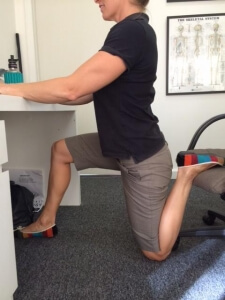There are a few different types of knee injuries and my goal here isn’t to discuss every single type of injury. Ligament tears, meniscus injuries, patellar dislocation etc. are probably not as common in Crossfit as those of more a chronic/repetitive type injury (patellar tendinopathy, bursitis, etc).
Anatomy
The knee is actually made up of two joints: the tibiofemoral joint (the joint between your tibia and femur) and the patellofemoral joint (the joint between your patella and your femur) which are stabilized by the collateral ligaments, cruciate ligaments and mensicus. The quadriceps, gracillis, iliotibial band, popliteus, sartorius, hamstrings and calves provide muscular stability and assist in movement (flexion, extension and some rotation).
Pain in this area can be associated with injury to any of the structures directly connected to the knee, but can also be from other structures upstream (lumbar spine, SIJ, hip) and/or downstream (ankle).
Common Causes of Knee Pain
Two of the most common causes of knee pain (anterior/front of knee) is patellofemoral joint problems and patellar tendinopathy. The signs and symptoms of each problem help to distinguish the diagnosis.
Patellofemoral Pain
– comes on with running/weight bearing activity involving bending of the knee
– pain aggravated by activities that load the knee eg. squatting, jumping
– sometimes associated with clicking and “crunchiness” under the kneecap
– weak VMO (inner quads)
– tight vastus lateralis (outer quads), TFL
– often associated with foot pronation (flat feet) and valgus knees (knock knees)
Patellar Tendinopathy
– comes on with jumping/change of direction/squatting
– pain is at the base of the patella
– pain aggravated by decline board squats
– tenderness of patellar tendon
– associated tightness of quads, hamstrings, possible pelvic biomechanical issues
– calf weakness commonly found
Treatment of each of these conditions varies so it’s always best if you get a Physio to do an assessment. Self diagnosis via “Dr Google” can be misleading, not to mention you could be wasting your time barking up the wrong tree. In any case, addressing the tissues around the knee can be a good place to start. MobilizeMe Physio on the Gold Coast offers FREE initial assessments for new clients. So stop guessing and get some real answers!
You can also try rolling out/trigger pointing/stretching the quads, hamstrings, calves, adductors and glutes and see if it changes your pain. MobilizeMe App is a great resource for mobility exercises – check it out here. Make sure to test first (whatever movement causes the pain) and re-test post rollout to see if you have made change. No change = see MobilizeMe Physio for an assessment! Change = keep it up!

Hip Flexor Stretch

